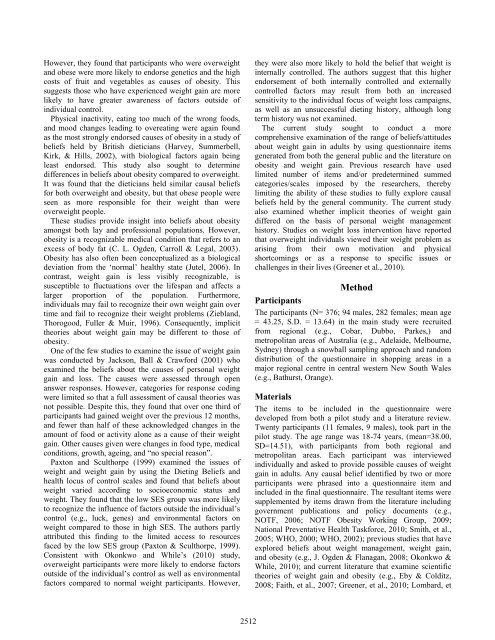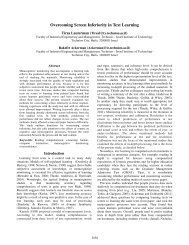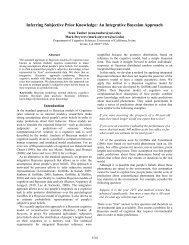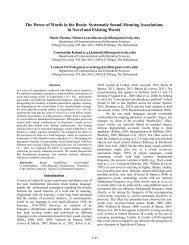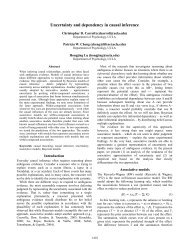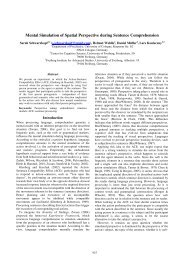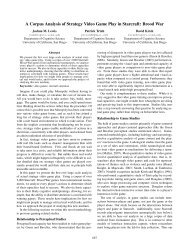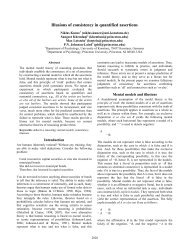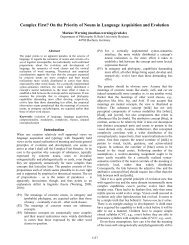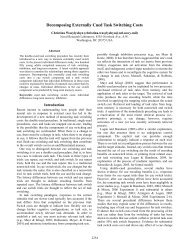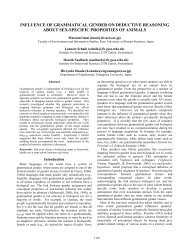Implicit theories of the causes of weight gain in adults
Implicit theories of the causes of weight gain in adults
Implicit theories of the causes of weight gain in adults
Create successful ePaper yourself
Turn your PDF publications into a flip-book with our unique Google optimized e-Paper software.
However, <strong>the</strong>y found that participants who were over<strong>weight</strong><br />
and obese were more likely to endorse genetics and <strong>the</strong> high<br />
costs <strong>of</strong> fruit and vegetables as <strong>causes</strong> <strong>of</strong> obesity. This<br />
suggests those who have experienced <strong>weight</strong> <strong>ga<strong>in</strong></strong> are more<br />
likely to have greater awareness <strong>of</strong> factors outside <strong>of</strong><br />
<strong>in</strong>dividual control.<br />
Physical <strong>in</strong>activity, eat<strong>in</strong>g too much <strong>of</strong> <strong>the</strong> wrong foods,<br />
and mood changes lead<strong>in</strong>g to overeat<strong>in</strong>g were a<strong>ga<strong>in</strong></strong> found<br />
as <strong>the</strong> most strongly endorsed <strong>causes</strong> <strong>of</strong> obesity <strong>in</strong> a study <strong>of</strong><br />
beliefs held by British dieticians (Harvey, Summerbell,<br />
Kirk, & Hills, 2002), with biological factors a<strong>ga<strong>in</strong></strong> be<strong>in</strong>g<br />
least endorsed. This study also sought to determ<strong>in</strong>e<br />
differences <strong>in</strong> beliefs about obesity compared to over<strong>weight</strong>.<br />
It was found that <strong>the</strong> dieticians held similar causal beliefs<br />
for both over<strong>weight</strong> and obesity, but that obese people were<br />
seen as more responsible for <strong>the</strong>ir <strong>weight</strong> than were<br />
over<strong>weight</strong> people.<br />
These studies provide <strong>in</strong>sight <strong>in</strong>to beliefs about obesity<br />
amongst both lay and pr<strong>of</strong>essional populations. However,<br />
obesity is a recognizable medical condition that refers to an<br />
excess <strong>of</strong> body fat (C. L. Ogden, Carroll & Legal, 2003).<br />
Obesity has also <strong>of</strong>ten been conceptualized as a biological<br />
deviation from <strong>the</strong> „normal‟ healthy state (Jutel, 2006). In<br />
contrast, <strong>weight</strong> <strong>ga<strong>in</strong></strong> is less visibly recognizable, is<br />
susceptible to fluctuations over <strong>the</strong> lifespan and affects a<br />
larger proportion <strong>of</strong> <strong>the</strong> population. Fur<strong>the</strong>rmore,<br />
<strong>in</strong>dividuals may fail to recognize <strong>the</strong>ir own <strong>weight</strong> <strong>ga<strong>in</strong></strong> over<br />
time and fail to recognize <strong>the</strong>ir <strong>weight</strong> problems (Ziebland,<br />
Thorogood, Fuller & Muir, 1996). Consequently, implicit<br />
<strong><strong>the</strong>ories</strong> about <strong>weight</strong> <strong>ga<strong>in</strong></strong> may be different to those <strong>of</strong><br />
obesity.<br />
One <strong>of</strong> <strong>the</strong> few studies to exam<strong>in</strong>e <strong>the</strong> issue <strong>of</strong> <strong>weight</strong> <strong>ga<strong>in</strong></strong><br />
was conducted by Jackson, Ball & Crawford (2001) who<br />
exam<strong>in</strong>ed <strong>the</strong> beliefs about <strong>the</strong> <strong>causes</strong> <strong>of</strong> personal <strong>weight</strong><br />
<strong>ga<strong>in</strong></strong> and loss. The <strong>causes</strong> were assessed through open<br />
answer responses. However, categories for response cod<strong>in</strong>g<br />
were limited so that a full assessment <strong>of</strong> causal <strong><strong>the</strong>ories</strong> was<br />
not possible. Despite this, <strong>the</strong>y found that over one third <strong>of</strong><br />
participants had <strong>ga<strong>in</strong></strong>ed <strong>weight</strong> over <strong>the</strong> previous 12 months,<br />
and fewer than half <strong>of</strong> <strong>the</strong>se acknowledged changes <strong>in</strong> <strong>the</strong><br />
amount <strong>of</strong> food or activity alone as a cause <strong>of</strong> <strong>the</strong>ir <strong>weight</strong><br />
<strong>ga<strong>in</strong></strong>. O<strong>the</strong>r <strong>causes</strong> given were changes <strong>in</strong> food type, medical<br />
conditions, growth, age<strong>in</strong>g, and “no special reason”.<br />
Paxton and Sculthorpe (1999) exam<strong>in</strong>ed <strong>the</strong> issues <strong>of</strong><br />
<strong>weight</strong> and <strong>weight</strong> <strong>ga<strong>in</strong></strong> by us<strong>in</strong>g <strong>the</strong> Diet<strong>in</strong>g Beliefs and<br />
health locus <strong>of</strong> control scales and found that beliefs about<br />
<strong>weight</strong> varied accord<strong>in</strong>g to socioeconomic status and<br />
<strong>weight</strong>. They found that <strong>the</strong> low SES group was more likely<br />
to recognize <strong>the</strong> <strong>in</strong>fluence <strong>of</strong> factors outside <strong>the</strong> <strong>in</strong>dividual‟s<br />
control (e.g., luck, genes) and environmental factors on<br />
<strong>weight</strong> compared to those <strong>in</strong> high SES. The authors partly<br />
attributed this f<strong>in</strong>d<strong>in</strong>g to <strong>the</strong> limited access to resources<br />
faced by <strong>the</strong> low SES group (Paxton & Sculthorpe, 1999).<br />
Consistent with Okonkwo and While‟s (2010) study,<br />
over<strong>weight</strong> participants were more likely to endorse factors<br />
outside <strong>of</strong> <strong>the</strong> <strong>in</strong>dividual‟s control as well as environmental<br />
factors compared to normal <strong>weight</strong> participants. However,<br />
2512<br />
<strong>the</strong>y were also more likely to hold <strong>the</strong> belief that <strong>weight</strong> is<br />
<strong>in</strong>ternally controlled. The authors suggest that this higher<br />
endorsement <strong>of</strong> both <strong>in</strong>ternally controlled and externally<br />
controlled factors may result from both an <strong>in</strong>creased<br />
sensitivity to <strong>the</strong> <strong>in</strong>dividual focus <strong>of</strong> <strong>weight</strong> loss campaigns,<br />
as well as an unsuccessful diet<strong>in</strong>g history, although long<br />
term history was not exam<strong>in</strong>ed.<br />
The current study sought to conduct a more<br />
comprehensive exam<strong>in</strong>ation <strong>of</strong> <strong>the</strong> range <strong>of</strong> beliefs/attitudes<br />
about <strong>weight</strong> <strong>ga<strong>in</strong></strong> <strong>in</strong> <strong>adults</strong> by us<strong>in</strong>g questionnaire items<br />
generated from both <strong>the</strong> general public and <strong>the</strong> literature on<br />
obesity and <strong>weight</strong> <strong>ga<strong>in</strong></strong>. Previous research have used<br />
limited number <strong>of</strong> items and/or predeterm<strong>in</strong>ed summed<br />
categories/scales imposed by <strong>the</strong> researchers, <strong>the</strong>reby<br />
limit<strong>in</strong>g <strong>the</strong> ability <strong>of</strong> <strong>the</strong>se studies to fully explore causal<br />
beliefs held by <strong>the</strong> general community. The current study<br />
also exam<strong>in</strong>ed whe<strong>the</strong>r implicit <strong><strong>the</strong>ories</strong> <strong>of</strong> <strong>weight</strong> <strong>ga<strong>in</strong></strong><br />
differed on <strong>the</strong> basis <strong>of</strong> personal <strong>weight</strong> management<br />
history. Studies on <strong>weight</strong> loss <strong>in</strong>tervention have reported<br />
that over<strong>weight</strong> <strong>in</strong>dividuals viewed <strong>the</strong>ir <strong>weight</strong> problem as<br />
aris<strong>in</strong>g from <strong>the</strong>ir own motivation and physical<br />
shortcom<strong>in</strong>gs or as a response to specific issues or<br />
challenges <strong>in</strong> <strong>the</strong>ir lives (Greener et al., 2010).<br />
Method<br />
Participants<br />
The participants (N= 376; 94 males, 282 females; mean age<br />
= 43.25, S.D. = 13.64) <strong>in</strong> <strong>the</strong> ma<strong>in</strong> study were recruited<br />
from regional (e.g., Cobar, Dubbo, Parkes,) and<br />
metropolitan areas <strong>of</strong> Australia (e.g., Adelaide, Melbourne,<br />
Sydney) through a snowball sampl<strong>in</strong>g approach and random<br />
distribution <strong>of</strong> <strong>the</strong> questionnaire <strong>in</strong> shopp<strong>in</strong>g areas <strong>in</strong> a<br />
major regional centre <strong>in</strong> central western New South Wales<br />
(e.g., Bathurst, Orange).<br />
Materials<br />
The items to be <strong>in</strong>cluded <strong>in</strong> <strong>the</strong> questionnaire were<br />
developed from both a pilot study and a literature review.<br />
Twenty participants (11 females, 9 males), took part <strong>in</strong> <strong>the</strong><br />
pilot study. The age range was 18-74 years, (mean=38.00,<br />
SD=14.51), with participants from both regional and<br />
metropolitan areas. Each participant was <strong>in</strong>terviewed<br />
<strong>in</strong>dividually and asked to provide possible <strong>causes</strong> <strong>of</strong> <strong>weight</strong><br />
<strong>ga<strong>in</strong></strong> <strong>in</strong> <strong>adults</strong>. Any causal belief identified by two or more<br />
participants were phrased <strong>in</strong>to a questionnaire item and<br />
<strong>in</strong>cluded <strong>in</strong> <strong>the</strong> f<strong>in</strong>al questionnaire. The resultant items were<br />
supplemented by items drawn from <strong>the</strong> literature <strong>in</strong>clud<strong>in</strong>g<br />
government publications and policy documents (e.g.,<br />
NOTF, 2006; NOTF Obesity Work<strong>in</strong>g Group, 2009;<br />
National Preventative Health Taskforce, 2010; Smith, et al.,<br />
2005; WHO, 2000; WHO, 2002); previous studies that have<br />
explored beliefs about <strong>weight</strong> management, <strong>weight</strong> <strong>ga<strong>in</strong></strong>,<br />
and obesity (e.g., J. Ogden & Flanagan, 2008; Okonkwo &<br />
While, 2010); and current literature that exam<strong>in</strong>e scientific<br />
<strong><strong>the</strong>ories</strong> <strong>of</strong> <strong>weight</strong> <strong>ga<strong>in</strong></strong> and obesity (e.g., Eby & Colditz,<br />
2008; Faith, et al., 2007; Greener, et al., 2010; Lombard, et


